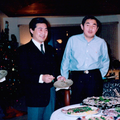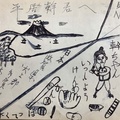Kazuko (Katy) Makihara was born into the Fukuhara family on September 26, 1933 in her parents’ home near Vancouver Cannery on Sea Island (now the location of Vancouver International Airport). Her birth was assisted by a Japanese midwife, Ms. Watanabe. She had an older sister, Hisaye, a younger sister, Judy, and a younger brother, Akio.
Kazuko’s parents were from Onomichi, Hiroshima. Her father first came to Canada because he was adopted by a childless aunt and uncle who were fishermen there. His adoptive parents apparently were quite prosperous as they had a big house and were lending money to several other fishermen. Like his adoptive father, he worked as a fisherman.
Later his adoptive parents advised him to go back to Japan to find a wife, which he did, following the Japanese tradition of arranged marriages, and then returned with his bride to Canada. They lived on Sea Island, which is now the location of the Vancouver International Airport. Kazuko’s father, in contrast to many Japanese immigrants who labored in various seasonal jobs, was able to lead an economically stable life and was always a fisherman. He had his own boat which he had been given by his adoptive father. The fishing business went well for him, and he intended to stay permanently in Canada.
Kazuko thinks that her parents enjoyed their life in Canada despite the fact that they worked very hard. She remembers that their living room was very big, her mother was always having people over for meals, and she used to cook for a lot of people at a time.
Economically they were well established because Kazuko’s grandparents had been in Canada for a relatively long time and were successful at fishing. Unlike many other Japanese Canadian fishermen, her father never lost his fishing license when the government was reducing the number of licenses granted to Japanese Canadian fishermen, and he was able to keep working as a fisherman right up to the time of the uprooting and incarceration.
Kazuko remembers him as very industrious but quiet and not particularly outgoing or friendly. He was quite a heavy drinker, and her mother used to brew a lot of rice liquor for him at home. In contrast to her father, Kazuko’s mother was more friendly and outgoing but spoke her opinions frankly, which occasionally led to quarreling with family members.
Like many other Japanese Canadians of their generation, Kazuko’s parents were too busy working to have time for study, and everybody around them was Japanese, so they didn’t learn English well. They had little time for anything besides working and raising children.
Kazuko attended a Canadian public kindergarten on Sea Island. She can’t recall many of the names of her childhood friends, but does remember going on her father’s boat to visit some friends who lived in the Marpole area of Vancouver. She also remembers some of the merchant shops of Powell Street delivering goods to her home on Sea Island.
Her elementary school was also public. She enjoyed school life, and her ambition was to be a kindergarten teacher as she liked helping people. Some of her friends wanted to become nurses, but were discouraged from pursuing their ambitions as Japanese Canadians were excluded from almost all professions including teaching and nursing.
Although she herself doesn’t remember, some of her friends have told her that she was a real tomboy. They remembered that, as a child, she usually played with the boys, and sometimes pushed them around. One friend recalls that her little brother was pushed into a puddle by Kazuko and started crying. Although Kazuko cannot remember many details, she does recall that they did not have many toys and used to play a lot in the mud puddles.
Unlike many other kids of her age group, Kazuko didn’t go to a Japanese language school, and only learned Japanese because her parents spoke it at home. Her parents were too busy to teach her how to read and write in Japanese, so she only learned how to speak it. She thinks that at that time her first language was probably Japanese as her family and all her good friends were Japanese, but she also spoke English well because she had to speak it in the public school.
To be continued...
* This series is an abridged version of a paper titled, “A Japanese Canadian Teenage Exile: The Life History of Kazuko Makihara”, first published in The Journal of the Institute for Language and Culture (Konan University), March 15, 2019, pp. 3-20.
© 2019 Stanley Kirk







